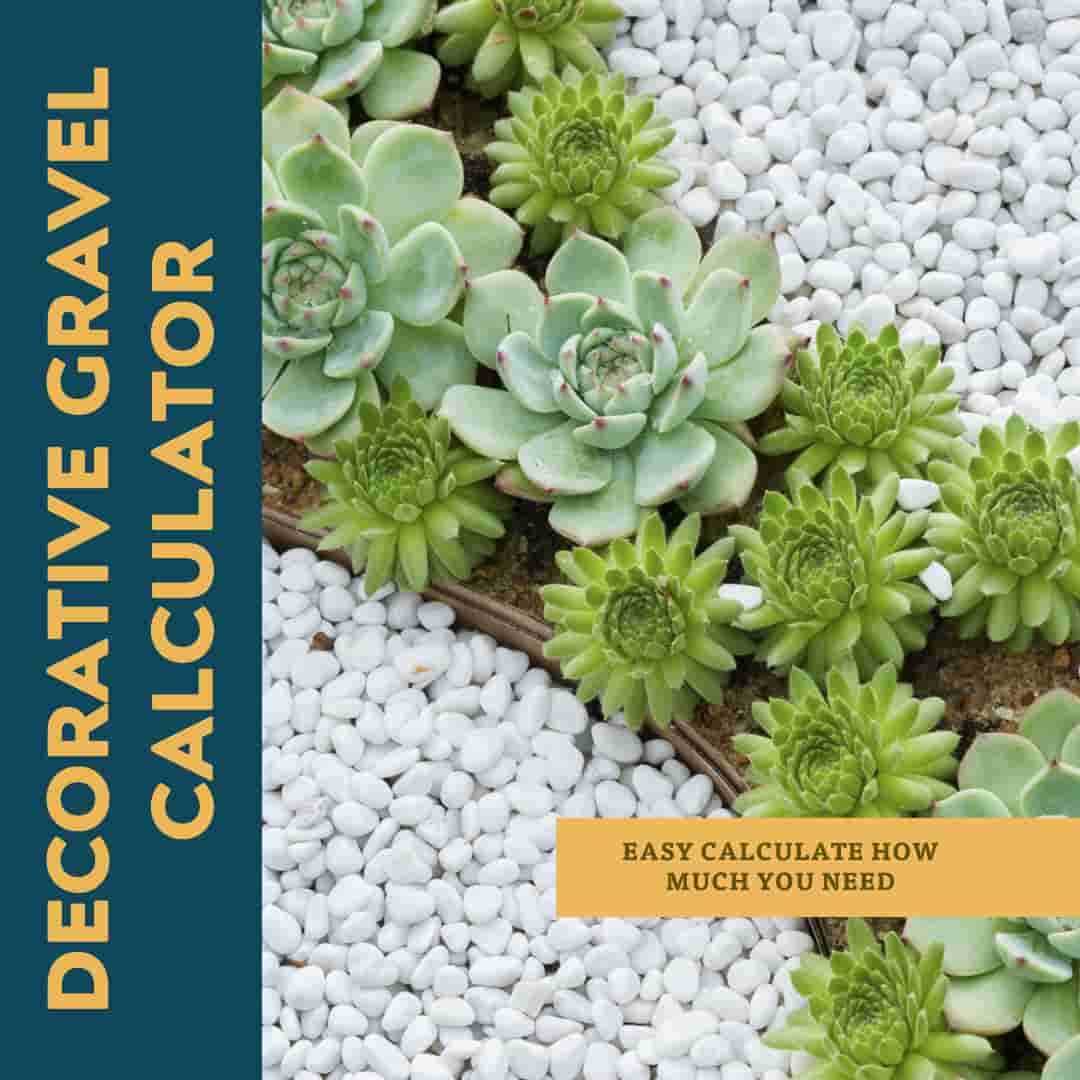The Decorative Gravel Calculator is a user-friendly tool designed to assist you in estimating the amount of gravel required for your landscaping projects. Whether you are planning to cover a pathway, driveway, garden bed, or any other area, this calculator provides you with a quick and reliable estimate of the gravel quantity needed.
Using the calculator is easy. Simply gather the measurements of the area you want to cover, including the length and width. Determine the desired depth of gravel coverage based on your project requirements. Enter these values into the calculator, ensuring that you use the correct units of measurement.
With just a click of a button, the calculator performs the necessary calculations and provides you with the estimated quantity of gravel required. The result is typically presented in cubic meters, which helps you determine the appropriate amount of gravel to purchase.
Please note that the calculator provides an estimate, and it’s always recommended to consider any additional factors specific to your project. Adjustments may be necessary to account for variations, adjustments during installation, or future maintenance needs.
The Gravel Quantity Calculator simplifies the planning process and assists you in achieving efficient and accurate gravel quantity estimations. By using this tool, you can save time, avoid wastage, and ensure a successful landscaping endeavor.
Remember, while the calculator offers valuable guidance, it’s always a good idea to consult with professionals or experts for more precise calculations and tailored advice based on your specific project requirements.
Decorative Gravel Calculator
How to use the calculator?
Using the calculator is simple
Follow these steps:
- Gather the necessary measurements: You will need to know the length and width of the area you want to cover with gravel. Make sure to measure in the same unit of measurement (e.g., meters, feet).
- Determine the desired depth: Decide on the depth of gravel coverage you want for your project. The recommended depth is typically around 5 cm (2 inches) for general landscaping. Ensure that you use the same unit of measurement as your length and width.
- Enter the values: On the calculator form, input the length, width, and depth measurements into the respective fields. Ensure that you use the correct units of measurement.
- Click on the “Calculate” button: After entering the measurements, click the “Calculate” button on the calculator.
- Obtain the results: The calculator will perform the necessary calculations and provide you with the estimated quantity of gravel needed. The result will be displayed on the screen, typically in cubic meters.
- Adjust if necessary: Consider any additional factors specific to your project. If needed, you can adjust the quantity by adding a little extra to account for variations, adjustments, or future maintenance.
Keep in mind that the calculator provides an estimate, and it’s always a good idea to consult with professionals or experts for more accurate calculations tailored to your specific needs. Additionally, different gravel types may have varying densities, so it’s advisable to consult with a local supplier for specific density values if necessary.
How much gravel do i need?
To determine how much gravel you need, you will need to gather the following information:
- Measure the length and width of the area you want to cover with gravel. Make sure to measure in the same unit of measurement (e.g., meters, feet).
- Decide on the desired depth of gravel coverage. This can vary depending on your project requirements but is typically around 5 cm (2 inches) for general landscaping.
Once you have this information, you can use the following formula to calculate the amount of gravel needed:
Gravel Quantity (in cubic meters) = Length (in meters) x Width (in meters) x Depth (in meters)
For example, let’s say you want to cover an area that measures 6 meters in length and 4 meters in width, with a desired depth of 5 cm. Using the formula:
Gravel Quantity = 6 meters x 4 meters x 0.05 meters Gravel Quantity = 1.2 cubic meters
In this example, you would need approximately 1.2 cubic meters of gravel to cover the specified area.
It’s important to note that this calculation provides an estimate, and it’s recommended to add a little extra to account for any variations or adjustments needed during the installation process. Additionally, keep in mind that different gravel types may have varying densities, so it’s advisable to consult with a local supplier for specific density values if necessary.
FAQ’s
What area will 1 ton of gravel cover?
The area that 1 ton of gravel will cover depends on the desired depth of coverage. To estimate the coverage, you need to convert the weight of 1 ton (in kilograms) to cubic meters by dividing it by the density of the gravel. The density can vary depending on the type of gravel. As a general guideline, assuming a density of 1500 kg/m³, 1 ton (1000 kg) of gravel will cover approximately 0.67 cubic meters.
How much will 850kg of gravel cover?
To determine how much area 850 kg of gravel will cover, you can use the same method as above. Assuming a density of 1500 kg/m³, 850 kg of gravel will cover approximately 0.57 cubic meters.
How do I calculate gravel for my garden?
To calculate the amount of gravel needed for your garden, follow the steps mentioned in the first answer. Measure the dimensions of the garden area, determine the desired depth of gravel coverage, and calculate the volume of gravel required in cubic meters.
How much does a 1 tonne bag of gravel cover?
The coverage of a 1-tonne bag of gravel depends on the desired depth. Using the same density assumption of 1500 kg/m³, a 1-tonne bag of gravel (1000 kg) will cover approximately 0.67 cubic meters.
How much ground will 25kg gravel cover?
The coverage of 25 kg of gravel will depend on the desired depth. You can divide the weight (in kilograms) by the desired depth (in meters) to estimate the coverage per square meter. For example, if you want a depth of 5 cm (0.05 meters), 25 kg of gravel will cover approximately 2.5 square meters.
How much gravel will 2 ton cover?
To determine how much gravel 2 tons will cover, you can use the same method as mentioned earlier. Assuming a density of 1500 kg/m³, 2 tons (2000 kg) of gravel will cover approximately 1.33 cubic meters.
What do you lay under gravel?
It is recommended to lay a suitable base material, such as geotextile fabric or a compacted layer of crushed stone, beneath the gravel. This helps to stabilize the ground, prevent weed growth, and improve drainage.
How much gravel do I need to cover 12 square meters?
To calculate the amount of gravel needed to cover 12 square meters, follow the steps mentioned earlier. Measure the dimensions, determine the desired depth, and calculate the volume of gravel required in cubic meters.
How much is a ton of gravel cost UK?
The cost of a ton of gravel in the UK can vary depending on factors such as the type of gravel, location, and supplier. It is advisable to check with local suppliers or search online to get current pricing information specific to your area.
Is 20mm gravel OK for driveway?
A 20mm gravel is generally suitable for driveways, as it provides good stability and drainage. However, it’s important to consider local regulations and specific requirements for your driveway project.
Author Profile

- I have many qualifications and certificates in construction, such as City & Guilds, CPCS and CITB. These are the highest standards of training and competence in the industry. Whether you need help with plumbing, carpentry, bricklaying or any other trade, I’m here to help you succeed.
Latest entries
- March 6, 2024CalculatorsWall Tile Calculator: How Many Wall Tiles Do You Need
- February 29, 2024Roof Truss Cost Calculator
- December 31, 2023Wage Take Home Calculator
- December 30, 2023Day Rate Calculator

